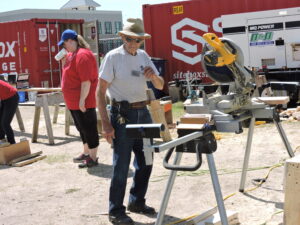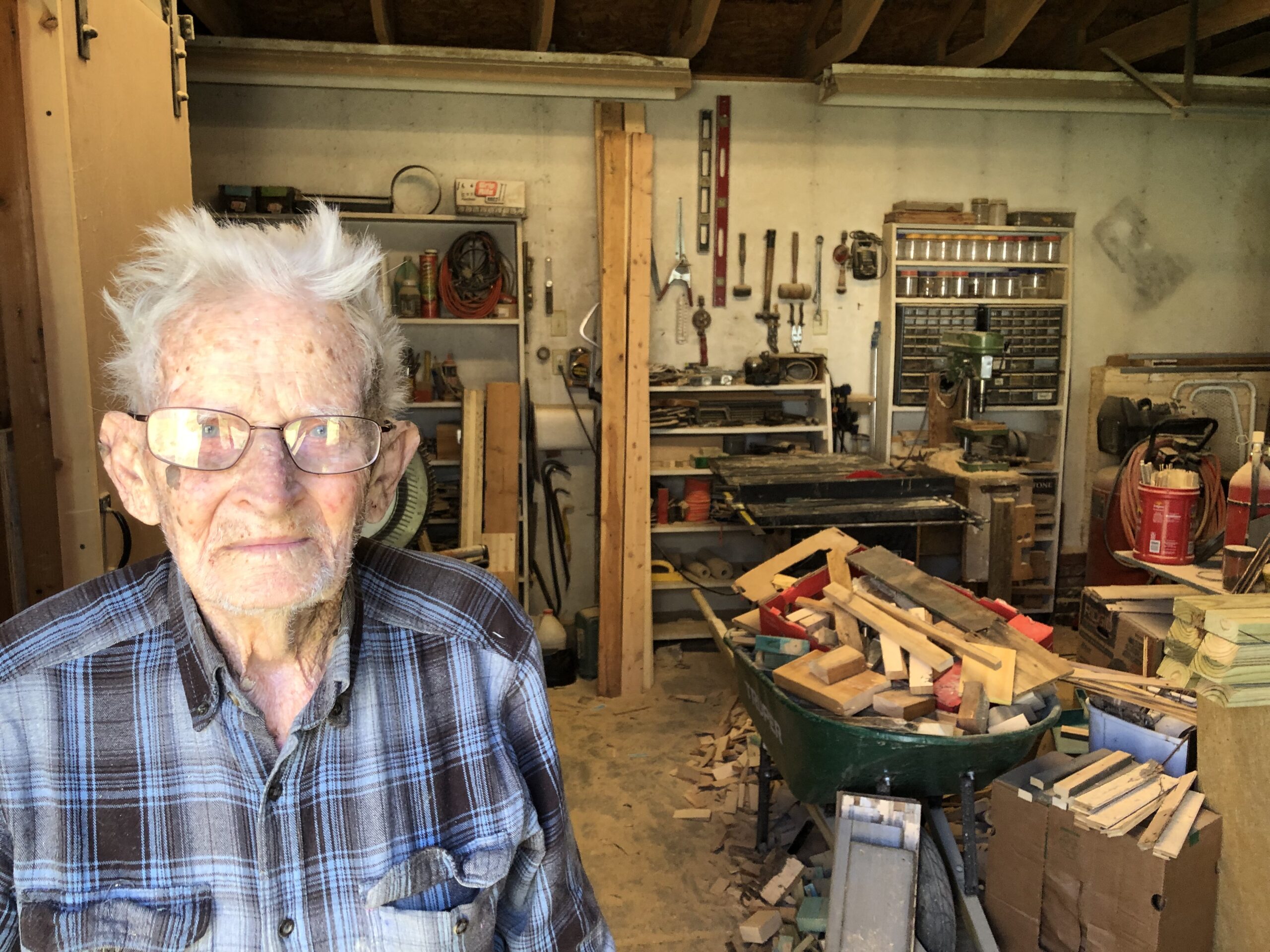You know your family’s been around Wichita awhile when it has a street named for it. Or in Don Martinson’s case, three of them.
There’s Martinson Street, which runs through Delano and south Wichita. It was named by Martinson’s grandfather, who developed much of Delano in the late 1880s. A little farther west are Charles and Clarence streets, named for his father and uncle, respectively. There was a fourth, named for his other uncle, Earl, but it’s now a boulevard called Athenian.
At 102 years old, Martinson is about as steeped in local history as it gets. But he’s hardly living in the past. Martinson delivered Meals on Wheels — a passion of his late wife, Gene, for Genevieve — until his 100th birthday. He still makes sawhorses for Habitat for Humanity construction crews along with trim and other items that go into the homes they build.
On a sunny morning in April, Martinson stands in his kitchen, icing a homemade chocolate sheet cake for an upcoming church fellowship meeting. He works carefully, consulting a hand-written recipe card and adding powdered sugar until the texture is just right.
When a visitor notices a framed photograph of the city’s new mayor, Lily Wu, in his kitchen, Martinson talks about meeting her at a north-side political rally complete with rappers and drones last year.
“She came right over with arms wide and gives me a big hug,” Martinson said. “She’s a knockout.”
Then he goes back to icing the cake.

Don Martinson works with other volunteers at the site of a Habitat for Humanity home that was being built several years ago.
Family legacy
Martinson’s grandfather, Ola, came to the United States from Sweden, homesteading at what’s now Maize and Kellogg in the years after the Civil War. Ola and a partner operated a bakery in downtown Wichita before Ola bought 200 acres in west Wichita from another early pioneer, Enoch Dodge.
Ola developed eight housing additions in the area bordered by Seneca, Meridian, Second and Douglas (then called Chicago Avenue) and, with Robert Lawrence, donated the land for Friends University. “He was pretty wealthy in his day, I guess,” his grandson says. “Then came the bust. He lost, essentially, all of it.”
Ola died in 1922. Don’s father, who had graduated from Friends in 1908, earned a master’s degree in mechanical engineering from the University of Kasnas and went on to a career teaching college. In 1920, while driving with his wife, he was hit by a train crossing Douglas. One doctor gave him little chance of surviving.
“That was two years before I was born,” Martinson said. “He lived another 50 years and died at age 88.”
The family settled on a 10-acre farm near Pawnee and Seneca. “That’s how we got through the Depression,” Martinson said.” We raised our own food and had milk cows.”
Concientious objector
Martinson graduated as valedictorian with a physics degree from Friends in 1943 and declared as a concientious objector during World War II, much to the unhappiness of the local draft board. “The good Lord says love your enemies and turn the other cheek,” he said. “How are you going to kill them if you love them?”
Not that his war years were dull. Assigned to the Civilian Public Service proram, he was first sent to North Dakota, some 60 miles south of Canada, to clear land on which the government planned to resettle farmers displaced during the Dust Bowl years. He then volunteered for a research project known as the Minnesota Semi-Starvation Experiment, an attempt to figure out how the United States could best help famine victims in Europe and Asia after the war ended. Martinson was too late to be chosen as a participant but helped administer the experiment, recalling that subjects “looked pretty bony” before regaining their weight.
Martinson also volunteered for vaccination research in Philadelphia that was being done in response to outbreaks of yellow fever among soldiers overseas. Although part of the control group, he wound up getting hepatitis. “Therefore, all of my life I have not been able to give blood,” he said.
Finally, he was posted to an impoverished region of Puerto Rico, where he helped build a clinic and agricultural station and “learned a little bit of Spanish.”
After the war, Martinson earned a master’s degree in agronomy from Kansas State University. Without the means to set himself up in farming, he decided to follow his mother into teaching instead. He taught virtually every math and science course at North High over the course of 30 years, with two interesting breaks.
In 1958, as the United States reacted with alarm to the Soviet Union’s launching of the Sputnik satellite, Martinson and other math teachers were chosen for a one-year program held at Stanford University in California designed to help them teach heuristics, an approach to problem solving.
Then in 1972, Martinson responded to an acute teaching shortage in Australia by taking a one-year assignment in a suburb of Melbourne.
“It wasn’t a really high-paying job, but I could take my family with me and it was worth it,” he said.
Martinson also managed to do a litte pioneering himself, building two homes with his own hands in the Indian Hills addition when it was virtually empty.
The Martinsons had four children. Their first daughter, Susan, was a family physician who died in her 60s. Three more — Jim, Dale and Donna — live in Wichita. The family includes five grandchildren and seven great-grandchildren.
Retired, not tired
After retiring in 1985, he helped restore and move the building that houses the Midwest Genealogical Society — another interest of Gene’s — to its current home on Main Street. About the same time, he volunteered on a Mennonite project to rehabilitate homes in Planeview and became active with Habitat for Humanity as the local chapter was just getting started.
Dana Korkki, Habitat’s manager for new construction, estimates that Martinson has worked on over 300 homes for first-time home owners thorugh the years. Although Martinson no longer goes to the building sites, Korkki marvels at the shelving, trim and decorative pieces such as rosettes that Martinon produces in the woodworking shop that he built behind his current home.
“He takes our scrap lumber and makes these pieces out of it. He makes it beautiful, and it’s something that normally would have landed in a dumpster.”
He’s also helped improve the liveability of homes built by Habitat through the years by, for example, installing shelving for storage in dead space in kitchens and garages.
Korkki calls Martinson a “great craftsman,” but that’s not what impresses him most.
“He’s just so much about service above self. He’s always looking at how he can help families.”
Martinson credits his ability to stay productive to a combination of genetics, diet, avoiding drinking and smoking and being a self-described “workaholic.”
Volunteering for Habitat is particularly rewarding because of the organization’s focus on helping the working poor, he said.
“It was fun because you get to mee the future (home) owners,” he said. “That’s what the good Lord said — you’ve got to treat your neighbor like yourself, take care of widows and orphans and stuff like that.”









